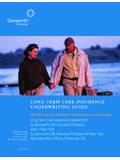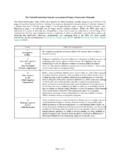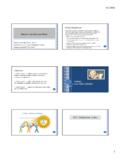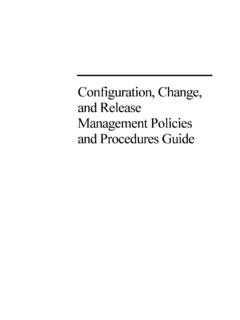Transcription of Question - Resource Brokerage
1 Question : We have a client whom keeps coming up with "nicotine" in his specimen. He is adamant that he does not smoke, chew or take nicotine supplements. His urine testing is showing with the lab range for "non-smokers" being He works in manufacturing and is around a lot of industrial smoke. Is there an occupation that causes a person to appear as a smoker when they are not?RiskTutor Coaching Reply: We have never heard of an occupational environment being the source of nicotine in a urine sample. We certainly have heard of numerous applicants who blame their abnormal lab test on other smokers. Take a look at Hank George's article on the nicotine issue and applicants who argue a "passive smoking" cause of their urine findings. You will want to save this link and use it with clients who are having a difficult time in admitting to any tobacco ordering medical files for clients, make sure you specifically request the client s medical provider to ensure that the medical file includes a detailed list of the client s current it clear to the physician s office that if this information is not clearly documented and updated in the medical file, you will need a written statement as to the exact medications currently prescribed for the client.
2 Poor medication information too often translates into poor underwriting outcome. | Rating Scales for DementiaUnderwriting CommentRating Scales for DementiaAgents and underwriters know that memory loss or cognition (thinking) problems in older adults can represent an early sign of dementia or possible Alzheimer s disease. Rating scales are "scoring systems" that are used to evaluate medical conditions. In dementia and Alzheimer s disease the rating scales are based on patient information, caregiver information and clinical observations. The findings are translated into numbers. Each scale then provides a "score" that can be used as evidence to support a diagnosis, serve as the basis for additional testing or provide a tool for monitoring the disease process. There are a number of rating scales that are used both in the initial assessment of dementia, as well as tracking the progression of Alzheimer s scales for dementia and Alzheimer s disease assess memory, cognition (how the patient is thinking), global function (how the patient is functioning in all aspects of their world), While not all older clients with memory loss or cognition problems will have Alzheimer s disease, a majority of these clients frequently undergo some form of evaluation that will usually include the use of a "rating scale.
3 "behavior, activities of daily living (ADLs), and disease severity. The following is a list of rating scales commonly employed in the clinical arena:MMSE-Mini-Mental State ExaminationThis rating scale is a brief, structured bedside or in-office examination. It evaluates memory and cognition. See this link for the actual MMSE test questions and how they are scored: s Disease Assessment Scale-Cognitive subscaleThis rating scale is a battery of tests that takes about an hour to administer. It evaluates cognition and it is scored between 0 (best) and 70 (worst).CGIC-Clinician s Global Impression of ChangeThis rating scale is based on the health care provider s "general clinical impressions" with or without the informant input ( family members). It evaluates global function and is scored from 1 (very much improved) to 7 (very much worsened).
4 CIBI-Clinician s Interview-Based ImpressionThis rating scale looks at 8 items based on patient and caregiver information. It evaluates global function and is scored like the and CIBIC-Plus-Clinician s Interview-Based Impression of Change and Clinician s Interview-Based Impression of Change with caregiver inputThis rating scale is a structured interview of the patient that is scored like the CGIC. It evaluates global function. The CIBIC-Plus includes the caregiver InventoryThis rating scale is composed of a 12 item structured interview of the caregiver and is scored from 0 to 120 (the higher the score, the greater the psychiatric disturbance). It evaluates Deterioration ScaleThis rating scale is a caregiver 29-item assessment that is scored from 0 (greatest impairment) to 100. It evaluates for Deterioration in Daily Living Activities in DementiaThis rating scale is a structured interview of the caregiver on 33 items and is scored from 33 to 233 (most severe).
5 It evaluates s Disease Cooperative StudyThis rating scale is a 23-item assessment of ADLs that is scored from 0 (greatest impairment) to 78. It evaluates Assessment for Dementia ScaleThis rating scale is a 46-item structured interview or questionnaire for the caregiver that is scored from 0 to 100 (least impairment). It evaluates Deterioration ScaleThis rating scale is a clinician-rated staging scale that is scored from 1 (normal) to 7 (advanced dementia). It evaluates disease rating scale is a structured interview with the patient and an informant that is scored from 0 (no impairment) to 3 (severe impairment).CDR-Clinical Dementia Rating ScaleUnderwriting CommentRating scales can be very helpful in the underwriting assessment of applicants with "suspected" or "known" dementia. For life insurance and LTC agents, the most important rating scale to be familiar with is the MMSE.
6 This is the rating scale that is most often used in clinical and insurance medicine, especially for applicants with "suspected" dementia. Underwriters are most likely to request an MMSE in cases where underwriting evidence is "suggestive" of dementia issues, but considering rating scales, dementia and underwriting, it is important to keep the following items in mind:1. A rating scale is only as good as the clinician using means that rating scales are subject to "operator error" and need to be viewed in the context of the "complete" package of underwriting Rating scales do not confirm a means that they are used to assess and monitor suspected or diagnosed cognitive problems. They are part of the evaluation and management of dementia-based disease, but are not "diagnostic tools" unto Rating scales do not exist in a means that they need to be viewed in the context of the applicant s entire medical history and clinical findings.
7 While the results can form a piece of the underwriting puzzle, they by no means represent the entire Underwrite the applicant, not the rating means that agents need to present as much information as possible to insure that the applicant is fairly assessed. See this underwriting article on "functional ability" and older clients to become familiar with what additional information is critical to the process: Copyright 2002, RiskTutor Inc.








